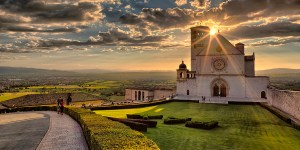The tradition of the walking pilgrimage in Italy dates back to the 10th century. In 990, the newly ordained archbishop of Canterbury, Sigerico, journeyed from Canterbury, England, to Rome to meet Pope John XV to receive his pallium -- the special sign of office given by the pope to archbishops. On his return, he kept a diary in which he meticulously recorded the details of his journey.
This is the first historical record of what became known as the Via Francigena. In time, the route became immensely popular as Christians from all over Europe set out to Rome on pilgrimage. After the Protestant Reformation of the 16th century, however, pilgrimages experienced significant decline.
Over the past two decades – largely due the success of the Spanish “Way” to the tomb of St. James of Compostela – walking pilgrimages in Italy have made a significant comeback.
There are so many, in fact, that the Italian ministry of tourism launched a website highlighting the numerous trails.
The Italian trails are an extraordinary way to connect with the country’s unparalleled religious and cultural heritage in addition to its natural scenery. Many are organized by associations that provide pilgrim’s passports and arrival testimonial certificates, both of which are invaluable mementos of the experience.
The trails are designed to be walked solo or in small groups. Accommodations, which can be booked in advance or on the spot, can be found on the trail websites.
Navigation is assured, as well, through guidebooks on the more popular trails, sign posts, or GPX tracks.
A GPX Track is an electronically recorded route created via GPS plotting. The tracks, available on the trail websites, can be uploaded onto a cell phone app or handheld GPS device.
Though the Italian Caminos can seem romantic and inviting, a word of caution is in order: many of the trails are physically demanding. As much of the country is mountainous – its topography is marked by the Alps in the north and the Apennines that run all the way down the peninsula – there is no way to make the trail easy.
Pilgrims frequently comment they are surprised by the rugged and varied terrain, and they were frequently unaware of the intensity of the steep climbs and descents that require exertion of different muscles they hadn’t trained for.
Thus, the more mountainous route should only be attempted by pilgrims who are physically fit.

Once the decision is made to go, here is a list of essential items to bring on the Camino:





